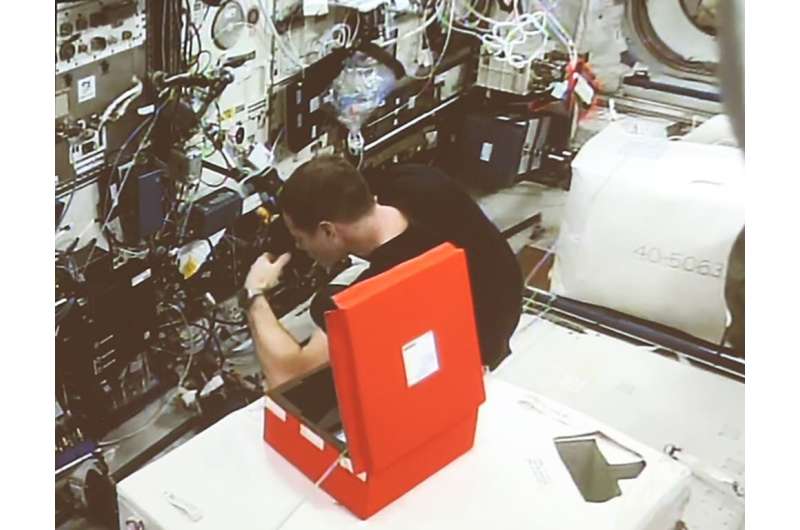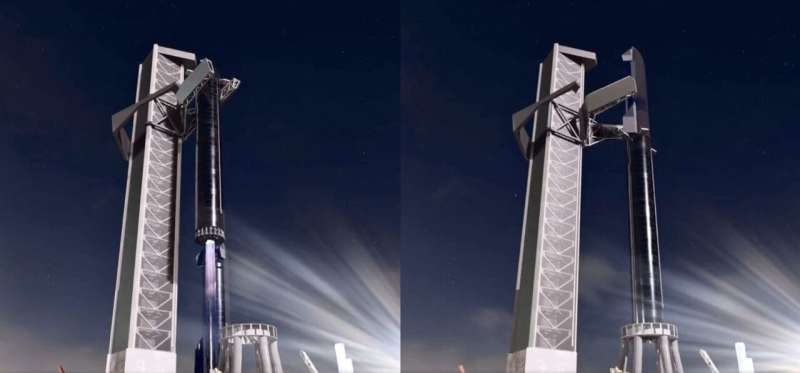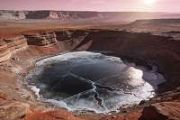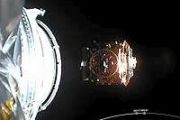
Copernical Team
Radiation-detecting optical fibers installed on the International Space Station

In a spacecraft, in order to protect both crew and electronics from radiation, it is mandatory to invest in effective radiation monitoring systems. The International Space Station (ISS), just like the Large Hadron Collider at CERN, is a complex radiation environment that requires bespoke dosimetry devices. Optical-fiber-based technologies can provide both distributed and point radiation dose measurements with high precision.
On 18 August, ESA astronaut Thomas Pesquet activated the Lumina experiment inside the ISS as part of the ALPHA mission. Developed under the coordination of the French Space Agency, CNES, and with the involvement of CERN, the Laboratoire Hubert Curien at the Université Jean-Monnet-Saint-Étienne, and iXblue, this project uses two several-kilometer-long optical fibers as active dosimeters to measure ionizing radiation in the ISS with very high sensitivity.
Week in images: 16 - 20 August 2021

Week in images: 16 - 20 August 2021
Discover our week through the lens
Musk hopes "Mechazilla" will catch and assemble the Starship and Super Heavy boosters for rapid reuse

In January of 2021, Elon Musk announced SpaceX's latest plan to increase the number of flights they can mount by drastically reducing turnaround time. The key to this was a new launch tower that would "catch" first stage boosters after they return to Earth. This would forego the need to install landing legs on future Super Heavy boosters and potentially future Starship returning to Earth.
Musk shared this idea in response to a tweet made by an animator who goes by the Twitter handle Erc X, who asked if his latest render (of a Starship landing next to its launch tower) was accurate. As usual, Musk responded via Twitter, saying:
"We're going to try to catch the Super Heavy Booster with the launch tower arm, using the grid fins to take the load… Saves mass & cost of legs & enables immediate repositioning of booster on to launch mount—ready to refly in under an hour."
Mechazilla #SpaceX#Starship@elonmuskpic.twitter.com/0hUWHj1BKe
— Erc X (@ErcXspace) August 13, 2021
The ground crews at SpaceX's South Texas Launch Facility near Boca Chica recently finished stacking the nine sections of bolted steel that make up the tower, which now stands about 145 m (440 ft) tall.
A-74 iceberg near collision with Brunt Ice Shelf
 Image:
New radar images show the A-74 iceberg spinning around the western tip of the Brunt Ice Shelf, brushing slightly against it before continuing southwards.
Image:
New radar images show the A-74 iceberg spinning around the western tip of the Brunt Ice Shelf, brushing slightly against it before continuing southwards. Greenland, Antarctica will respond differently to increased future warming
 The recently released IPCC Sixth Assessment Report predicts faster warming of Earth's atmosphere and oceans compared to previous assessments. Now, new research shows how the new generation of climate models used in the assessment differ from earlier models in their prediction of the impact on the Antarctic and Greenland ice sheets on sea level rise.
The new study predicts that, by 2100, ad
The recently released IPCC Sixth Assessment Report predicts faster warming of Earth's atmosphere and oceans compared to previous assessments. Now, new research shows how the new generation of climate models used in the assessment differ from earlier models in their prediction of the impact on the Antarctic and Greenland ice sheets on sea level rise.
The new study predicts that, by 2100, ad FSU researchers refine estimate of amount of carbon in Earth's outer core
 New research from Florida State University and Rice University is providing a better estimate of the amount of carbon in the Earth's outer core, and the work suggests the core could be the planet's largest reservoir of that element.
The research, published in the journal Communications Earth and Environment, estimates that 0.3 to 2.0 percent of the Earth's outer core is carbon.
Thoug
New research from Florida State University and Rice University is providing a better estimate of the amount of carbon in the Earth's outer core, and the work suggests the core could be the planet's largest reservoir of that element.
The research, published in the journal Communications Earth and Environment, estimates that 0.3 to 2.0 percent of the Earth's outer core is carbon.
Thoug NASA watches water to help grow our groceries
 Every day - up to thirty times a day, in fact - one of Mark Mason's employees at Nature's Reward Farms in Monterey County, California brings him the results of a soil test for discussion.
Mason supervises fertilizer and irrigation for the farm's 5,000 acres along California's Central Coast, which is nicknamed "America's Salad Bowl" and is one of the most productive and diverse agricultural
Every day - up to thirty times a day, in fact - one of Mark Mason's employees at Nature's Reward Farms in Monterey County, California brings him the results of a soil test for discussion.
Mason supervises fertilizer and irrigation for the farm's 5,000 acres along California's Central Coast, which is nicknamed "America's Salad Bowl" and is one of the most productive and diverse agricultural New chip scale atomic clock best yet for extreme environments
 Advanced military platforms, ocean-bottom survey systems and remote sensing applications all require precise timing for mission success. Chip Scale Atomic Clocks (CSACs) ensure stable and accurate timing even when Global Navigation Satellite Systems (GNSS) time signals are unavailable. Helping industrial and military system designers to meet this requirement, Microchip Technology Inc. has announ
Advanced military platforms, ocean-bottom survey systems and remote sensing applications all require precise timing for mission success. Chip Scale Atomic Clocks (CSACs) ensure stable and accurate timing even when Global Navigation Satellite Systems (GNSS) time signals are unavailable. Helping industrial and military system designers to meet this requirement, Microchip Technology Inc. has announ Scientists detect never-before-seen radio waves from nearby stars and distant galaxies
 Scientists have measured thousands of nearby stars and far away galaxies that have never been identified before at radio wavelengths, while studying a galactic body that neighbours our own Milky Way galaxy - the Large Magellanic Cloud.
Led by Keele University PhD student Clara M. Pennock and Reader in Astrophysics, Dr Jacco van Loon, the international team of researchers used the Australia
Scientists have measured thousands of nearby stars and far away galaxies that have never been identified before at radio wavelengths, while studying a galactic body that neighbours our own Milky Way galaxy - the Large Magellanic Cloud.
Led by Keele University PhD student Clara M. Pennock and Reader in Astrophysics, Dr Jacco van Loon, the international team of researchers used the Australia Researchers from IRSOL and IAC solve twenty-year-old paradox in solar physics
 In 1998, the journal Nature published a seminal letter concluding that a mysterious signal, which had been recently discovered analysing the polarization of sunlight, implies that the solar chromosphere (a very important layer of the solar atmosphere) is practically unmagnetised, in sharp contradiction with common wisdom. This paradox motivated laboratory experiments and theoretical investigatio
In 1998, the journal Nature published a seminal letter concluding that a mysterious signal, which had been recently discovered analysing the polarization of sunlight, implies that the solar chromosphere (a very important layer of the solar atmosphere) is practically unmagnetised, in sharp contradiction with common wisdom. This paradox motivated laboratory experiments and theoretical investigatio 



































